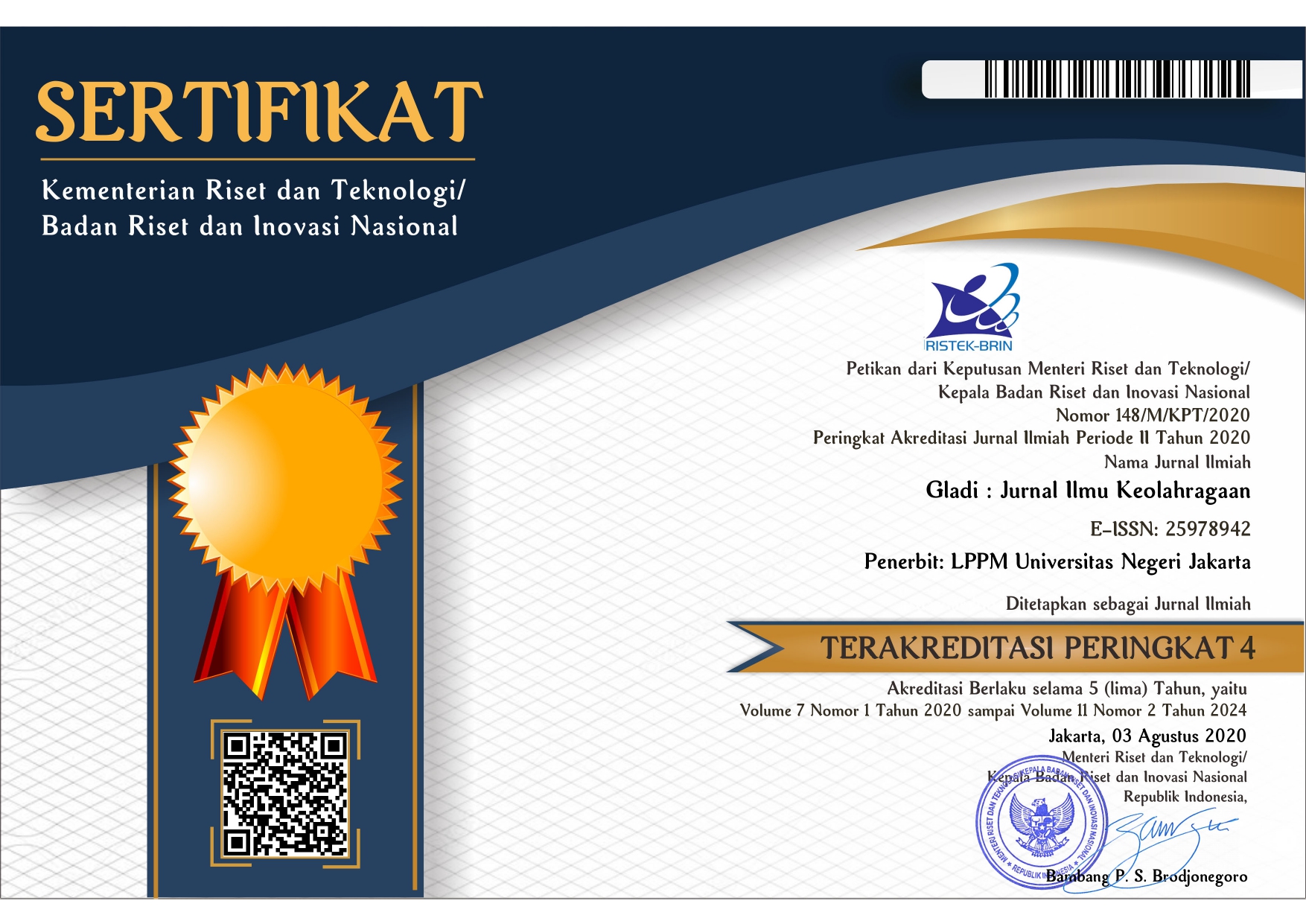THE INFLUENCE OF BODY TYPE, STRENGTH, AND FLEXIBILITY ON INJURY OCCURRENCE AMONG STOK BINA GUNA STUDENTS IN ARTISTIC GYMNASTICS SUBJECT
DOI:
https://doi.org/10.21009/GJIK.152.9Keywords:
gymnastics, injuries, preventionAbstract
Objectives—This pilot project, aimed at investigating body type, strength, and flexibility as risk factors for injury amongst Bina Guna College of Sports and Health Students, has yielded significant findings. Methods—Fifteen subjects volunteered to participate in the present study. An ex-post facto study design using independent samples was employed. Injury history was established through the use of a questionnaire. From this information, each individual's injury status was categorized as "high" or "low" using a previously designed and validated scoring system. Body-type ratings were determined, followed by tests to assess muscular endurance, strength, and flexibility. Results—A multivariate analysis of variance (MANOVA) revealed no significant difference between groups of low and high injury rates and the dependent variables selected. However, the univariate analysis suggested trends indicating that the low-injury subjects were more flexible (back extension and ankle dorsiflexion) than those who reported more injuries (P=0.013). Independent t-tests revealed that between groups of low and high injury rates, there were significant age differences (P=0.002), stature (P=0.006), body mass (P=0.001), and years of gymnastics training (P=0.016). Conclusions—In the present study, strength, and body type proved not to be good indicators of an individual's susceptibility to injury. However, trends suggest low flexibility levels may predispose a gymnast to injury. The incidence of injury may also be related to the number of years an individual has participated in competitive gymnastics. In addition, older, taller, and heavier gymnasts may be at greater risk of injuries. These findings are crucial for the development of tailored training methods and injury prevention strategies, and they have significant implications for coaches in selecting and training future gymnasts
Downloads
References
Bonanno, J., Casey, E., & Faustin, M. (2023). The youth athlete: Gymnastics. The Youth Athlete: A Practitioner’s Guide to Providing Comprehensive Sports Medicine Care, 811–824. https://doi.org/10.1016/B978-0-323-99992-2.00078-5
Caine, D., Maffulli, N., & Caine, C. (2008). Epidemiology of Injury in Child and Adolescent Sports: Injury Rates, Risk Factors, and Prevention. Clinics in Sports Medicine, 27(1), 19–50. https://doi.org/10.1016/J.CSM.2007.10.008
Clarke, H. H. (1976). Application of measurement to health and physical education . Prentice-Hall.
Glynn, B., Laird, J., Herrington, L., Rushton, A., & Heneghan, N. R. (2022). Analysis of landing performance and ankle injury in elite British artistic gymnastics using a modified drop land task: A longitudinal observational study. Physical Therapy in Sport, 55, 61–69. https://doi.org/10.1016/J.PTSP.2022.01.006
Grigore, V., Cosma, G., & Păunescu, M. (2014). Retrospective Study Regarding Artistic Gymnastics Injuries. Procedia - Social and Behavioral Sciences, 117, 45–49. https://doi.org/10.1016/J.SBSPRO.2014.02.176
Hart, E., Bauer, A. S., & Bae, D. S. (2024). Common upper extremity gymnastics injuries and gymnastic specific return to play protocols. Journal of the Pediatric Orthopaedic Society of North America, 6, 100016. https://doi.org/10.1016/J.JPOSNA.2024.100016
Lubis, H., Setiakarnawijaya, Y., Jauhari, M., Jasmani Kesehatan dan Rekreasi, P., Tinggi Olahraga dan Kesehatan Bina Guna, S., Jasmani, P., & Jurnal, G. (2023). The Effect of Arm Muscle Power, Waist Flexibility, And Self-Confidence on Front Handspring Skills in Artistics Gymnastics. Gladi : Jurnal Ilmu Keolahragaan, 14(03), 357–368. https://doi.org/10.21009/GJIK.143.10
Mills, C., Pain, M. T. G., & Yeadon, M. R. (2009). Reducing ground reaction forces in gymnastics’ landings may increase internal loading. Journal of Biomechanics, 42(6), 671–678. https://doi.org/10.1016/J.JBIOMECH.2009.01.019
Nelson, J. K., & Johnson, B. L. (1986). Practical Measurements for Evaluation in Physical Education (Subsequent). Macmillan Pub Co.
Pain, M. T. G., Mills, C., & Yeadon, M. R. (2007). Optimising Landing Strategies to Minimise Injury Risk During Gymnastics Landings. Journal of Biomechanics, 40, S200. https://doi.org/10.1016/S0021-9290(07)70196-3
Purnell, M., Shirley, D., Nicholson, L., & Adams, R. (2010). Acrobatic gymnastics injury: Occurrence, site and training risk factors. Physical Therapy in Sport, 11(2), 40–46. https://doi.org/10.1016/J.PTSP.2010.01.002
Richmond, S. A., Kang, J., & Emery, C. A. (2013). Is body mass index a risk factor for sport injury in adolescents? Journal of Science and Medicine in Sport, 16(5), 401–405. https://doi.org/10.1016/J.JSAMS.2012.11.898
Downloads
Published
How to Cite
Issue
Section
License
Copyright (c) 2024 Hafiz Yazid Lubis

This work is licensed under a Creative Commons Attribution-ShareAlike 4.0 International License.







